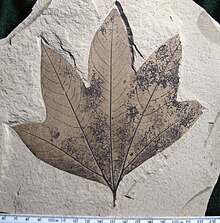| Macginitiea Temporal range:
| |
|---|---|

| |
| Macginitiea gracilis | |
| Scientific classification | |
| Kingdom: | Plantae |
| Clade: | Tracheophytes |
| Clade: | Angiosperms |
| Clade: | Eudicots |
| Order: | Proteales |
| Family: | Platanaceae |
| Genus: | †Macginitiea Wolfe & Wehr (1987) |
| Type species | |
| Macginitiea gracilis | |
| Species | |
| |
Macginitiea is an extinct genus in the family Platanaceae ranging from the Late Paleocene to Late Eocene of North America, known from the Clarno Formation of central Oregon and other areas ranging from California to Texas and North to Alberta.[1][2] The genus is strictly used to describe leaves, but has been found in close association with other fossil platanoid organs, which collectively have been used for whole plant reconstructions.[2][3] Macginitiea and its associated organs are important as together they comprise one of the most well-documented and ubiquitous fossil plants, particularly in the Paleogene of North America.[4][5]
Because paleobotanical material is often found in disarticulation, different species names are often used to refer to different organs (e.g. leaves, fruits, wood) even if those organs might have belonged to the same plant. When these organ species are considered together as a whole plant, the study is known as a whole plant reconstruction. Some localities have enough co-occurrences of different fossil plant organs that whole plant reconstructions are possible, one example being the Cercidiphyllum-like Joffrea from the Joffre Bridge locality of Alberta, Canada.[6]
- ^ Retallack, G.J. (1996). "Reconstructions of Eocene and Oligocene plants and animals of central Oregon". Oregon Geology. 58 (3): 51–59.
- ^ a b Manchester, S. R. (1986). "Vegetative and reproductive morphology of an extinct plane tree (Platanaceae) from the Eocene of western North America". Botanical Gazette. 147 (2): 200–226. doi:10.1086/337587. S2CID 83715341.
- ^ Pigg, K. B.; Stockey, R. A. (1991). "Platanaceous plants from the Paleocene of Alberta, Canada". Review of Palaeobotany and Palynology. 70 (1–2): 125–146. Bibcode:1991RPaPa..70..125P. doi:10.1016/0034-6667(91)90082-e.
- ^ Myers, J. A. (2003). Terrestrial Eocene-Oligocene Vegetation and Climate in the Pacific Northwest. From Greenhouse to Icehouse: The Marine Eocene-Oligocene Transition. Columbia University Press, New York, 171-185.
- ^ Maslova, N. P. (2008). "Association of vegetative and reproductive organs of platanoids (Angiospermae): significance for systematics and phylogeny". Paleontological Journal. 42 (12): 1393–1404. doi:10.1134/s0031030108120034. S2CID 84372555.
- ^ Crane, P. R.; Stockey, R. A. (1985). "Growth and reproductive biology of Joffrea speirsii gen. et sp. nov., a Cercidiphyllum-like plant from the Late Paleocene of Alberta, Canada". Canadian Journal of Botany. 63 (2): 340–364. doi:10.1139/b85-041.